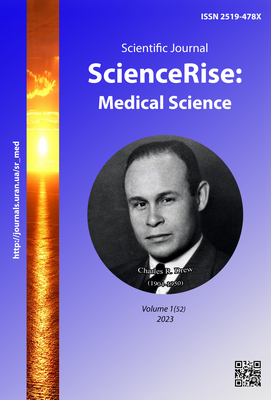Prognosis of abnormal uterine bleeding in women of reproductive age with extragenital disorders
DOI:
https://doi.org/10.15587/2519-4798.2023.275503Keywords:
abnormal uterine bleeding, discriminant analysis, risk prediction, mathematical model, classification functionsAbstract
The purpose of the study was to elaborate on a prognostic model for predicting the development of abnormal uterine bleeding in women of reproductive age with accompanying extragenital disorders based on mathematical methods.
Materials and methods. The study, which was in 2019-2022, involved 100 women of reproductive age with AUB and accompanying extragenital disorders under observation, who made up the main group. The control group comprised 50 women of reproductive age undergoing medical checkups. On the basis of 23 diagnostic indicators, the most informative ones were mathematically selected for the prognosis of AUB in women with extragenital abnormalities.
Results and their discussion. The prognosis of the risk of developing AUB in women of reproductive age with extragenital disorders was carried out on a double scale (0 – low probability, 1 – high probability). The search for diagnostically informative factors involved a set of 23 working indicators that were investigated in the examined patients using four levels of the risk scale. In order to solve this issue, the factors that have the greatest importance in the formation of the prognosis were selected using discriminant analysis methods, and a corresponding mathematical model was created. The classification functions made it possible to enter the practical plane and form rules for assessing the presence/absence of the risk of developing AUB in patients of reproductive age with extragenital disorders. The corresponding expressions are the following equations:
NP = BAS ART*75.57+FSH*2.96+prolac*0.02+estrad*0.02-40.78
PP = BAS ART*105.35+FSH*0.79+prolac*0.1+estrad*0.08-114.49,
where NP is a negative prognosis, PP is a positive prognosis.
If NP > PP, then the most likely prognosis is the absence of AUB in the patient; otherwise, if PP > NP – there is an increased risk of AUB.
Conclusion. Pulsation index in the basal arteries of the uterus, FSH, prolactin and estrogens are prognostically significant indicators for predicting the risk of abnormal uterine bleeding in patients of reproductive age with extragenital disorders. The above formula, obtained from the conducted discriminant analysis, makes it possible to predict bleeding in a specific patient
References
- Marnach, M. L., Laughlin-Tommaso, S. K. (2019). Evaluation and Management of Abnormal Uterine Bleeding. Mayo Clinic Proceedings, 94 (2), 326–335. doi: https://doi.org/10.1016/j.mayocp.2018.12.012
- Munro, M. G., Critchley, H. O. D., Fraser, I. S. (2018). The two FIGO systems for normal and abnormal uterine bleeding symptoms and classification of causes of abnormal uterine bleeding in the reproductive years: 2018 revisions. International Journal of Gynecology & Obstetrics, 143 (3), 393–408. doi: https://doi.org/10.1002/ijgo.12666
- Critchley, H. O. D., Maybin, J. A., Armstrong, G. M., Williams, A. R. W. (2020). Physiology of the Endometrium and Regulation of Menstruation. Physiological Reviews, 100 (3), 1149–1179. doi: https://doi.org/10.1152/physrev.00031.2019
- Kazemijaliseh, H., Ramezani Tehrani, F., Behboudi-Gandevani, S., Khalili, D., Hosseinpanah, F., Azizi, F. (2017). A Population-Based Study of the Prevalence of Abnormal Uterine Bleeding and its Related Factors among Iranian Reproductive-Age Women: An Updated Data. Archives of Iranian medicine, 20 (9), 558–563.
- Marie, K. J., Cyrille, N. N. C., Etienne, B., Pascal, F. (2020). Epidemiological Profile of Abnormal Uterine Bleeding at the Gyneco-Obstetric and Pediatric Hospital of Yaounde. Open Journal of Obstetrics and Gynecology, 10 (2), 237–242. doi: https://doi.org/10.4236/ojog.2020.1020020
- Cheong, Y., Cameron, I. T., Critchley, H. O. D. (2019). Abnormal uterine bleeding. British Medical Bulletin, 131 (1), 119. doi: https://doi.org/10.1093/bmb/ldz008
- Croft, P., Dinant, G.-J., Coventry, P., Barraclough, K. (2015). Looking to the future: should ‘prognosis’ be heard as often as ‘diagnosis’ in medical education? Education for Primary Care, 26 (6), 367–371. doi: https://doi.org/10.1080/14739879.2015.1101863
- Obermeyer, Z., Emanuel, E. J. (2016). Predicting the Future – Big Data, Machine Learning, and Clinical Medicine. New England Journal of Medicine, 375 (13), 1216–1219. doi: https://doi.org/10.1056/nejmp1606181
- Sauvan, M., Pourcelot, A.-G., Fournet, S., Fernandez, H., Capmas, P. (2018). Office hysteroscopy for postmenopausal women: Feasibility and correlation with transvaginal ultrasound. Journal of Gynecology Obstetrics and Human Reproduction, 47 (10), 505–510. doi: https://doi.org/10.1016/j.jogoh.2018.08.018
- Xu, Y., Xie, D. (2022). Prediction of Factors Associated with Abnormal Uterine Bleeding by Transvaginal Ultrasound Combined with Bleeding Pattern. Computational and Mathematical Methods in Medicine, 2022, 1–8. doi: https://doi.org/10.1155/2022/5653250
- van Smeden, M., Reitsma, J. B., Riley, R. D., Collins, G. S., Moons, K. G. (2021). Clinical prediction models: diagnosis versus prognosis. Journal of Clinical Epidemiology, 132, 142–145. doi: https://doi.org/10.1016/j.jclinepi.2021.01.009
- Tuchkina, I. O., Vygivska, L. A., Novikova, A. A. (2020). Abnormal uterine bleeding in adolescents: current state of the problem. Wiadomości Lekarskie, 73 (8), 1752–1755. doi: https://doi.org/10.36740/wlek202008130
- Chodankar, R., Critchley, H. O. D. (2018). Biomarkers in abnormal uterine bleeding†. Biology of Reproduction, 101 (6), 1155–1166. doi: https://doi.org/10.1093/biolre/ioy231
Downloads
Published
How to Cite
Issue
Section
License
Copyright (c) 2023 Roman Blagoveshchensky, Iryna Tuchkina

This work is licensed under a Creative Commons Attribution 4.0 International License.
Our journal abides by the Creative Commons CC BY copyright rights and permissions for open access journals.
Authors, who are published in this journal, agree to the following conditions:
1. The authors reserve the right to authorship of the work and pass the first publication right of this work to the journal under the terms of a Creative Commons CC BY, which allows others to freely distribute the published research with the obligatory reference to the authors of the original work and the first publication of the work in this journal.
2. The authors have the right to conclude separate supplement agreements that relate to non-exclusive work distribution in the form in which it has been published by the journal (for example, to upload the work to the online storage of the journal or publish it as part of a monograph), provided that the reference to the first publication of the work in this journal is included.









